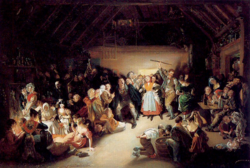Halloween or Hallowe'en (a contraction of its original title "All Hallows' Evening"),[5] also known as All Hallows' Eve,[6] is a yearly holiday observed around the world on October 31, the eve of the Western Christian feast of All Hallows. Most scholars believe that All Hallows' Eve was originally influenced by western European harvest festivals and festivals of the dead with pagan roots, particularly the Celtic Samhain.[6][7][8] Others maintain that it originated independently of Samhain.[9]
Typical festive Halloween activities include trick-or-treating (also known as "guising"), attending costume parties, carving pumpkins into jack-o'-lanterns, lighting bonfires, apple bobbing, visiting haunted attractions, playing pranks, telling scary stories, and watching horror films.
Christian influences
Snap-Apple Night (1832) by Daniel Maclise.
Depicts apple bobbing and divination games at a Halloween party in Blarney, Ireland.
Depicts apple bobbing and divination games at a Halloween party in Blarney, Ireland.
Halloween is also thought to have been influenced by the Christian holy days of All Saints' Day (also known as All Hallows, Hallowmas or Hallowtide) on 1 November and All Souls' Day on 2 November.[28] They were a time for honoring the saints
and praying for the recently departed who had yet to reach Heaven. All
Saints was introduced in the year 609, but was originally celebrated on
13 May.[29] In 835, it was switched to 1 November (the same date as Samhain) at the behest of Pope Gregory IV.[29] Some have suggested this was due to Celtic influence, while others suggest it was a Germanic idea.[29]
 By the end of the 12th century they had become holy days of obligation across Europe and involved such traditions as ringing bells for the souls in purgatory and "souling", the custom of baking and sharing soul cakes for "all crysten christened souls".[30]
Groups of poor people, often children, would go door-to-door on All
Saints/All Souls collecting soul cakes, originally as a means of praying
for souls in purgatory.[31] Similar practices for the souls of the dead were found as far south as Italy.[32] Shakespeare mentions the practice in his comedy The Two Gentlemen of Verona (1593), when Speed accuses his master of "puling [whimpering or whining] like a beggar at Hallowmas."[33]
The custom of wearing costumes has been linked to All Saints/All Souls
by Prince Sorie Conteh, who wrote: "It was traditionally believed that
the souls of the departed wandered the earth until All Saints' Day, and
All Hallows' Eve provided one last chance for the dead to gain vengeance
on their enemies before moving to the next world.
In order to avoid being recognised by any soul that might be seeking
such vengeance, people would don masks or costumes to disguise their
identities".[34] In Halloween: From Pagan Ritual to Party Night, Nicholas Rogers explained Halloween jack-o'-lanterns as originally being representations of souls in purgatory.[27]
By the end of the 12th century they had become holy days of obligation across Europe and involved such traditions as ringing bells for the souls in purgatory and "souling", the custom of baking and sharing soul cakes for "all crysten christened souls".[30]
Groups of poor people, often children, would go door-to-door on All
Saints/All Souls collecting soul cakes, originally as a means of praying
for souls in purgatory.[31] Similar practices for the souls of the dead were found as far south as Italy.[32] Shakespeare mentions the practice in his comedy The Two Gentlemen of Verona (1593), when Speed accuses his master of "puling [whimpering or whining] like a beggar at Hallowmas."[33]
The custom of wearing costumes has been linked to All Saints/All Souls
by Prince Sorie Conteh, who wrote: "It was traditionally believed that
the souls of the departed wandered the earth until All Saints' Day, and
All Hallows' Eve provided one last chance for the dead to gain vengeance
on their enemies before moving to the next world.
In order to avoid being recognised by any soul that might be seeking
such vengeance, people would don masks or costumes to disguise their
identities".[34] In Halloween: From Pagan Ritual to Party Night, Nicholas Rogers explained Halloween jack-o'-lanterns as originally being representations of souls in purgatory.[27]
In Britain, these customs came under attack during the Reformation as Protestants berated purgatory as a "popish" doctrine incompatible with the notion of predestination.[28] This, coupled with the rising popularity of Guy Fawkes Night (5 November) from 1605 onward, led to Halloween's popularity waning in Britain, with the noteworthy exception of Scotland.[35] There and in Ireland, they had been celebrating Samhain and Halloween since at least the early Middle Ages,[12] and the Scottish kirk took a more pragmatic approach to Halloween, seeing it as important to the life cycle and rites of passage of communities and thus ensuring its survival in the country.[35]


No comments:
Post a Comment